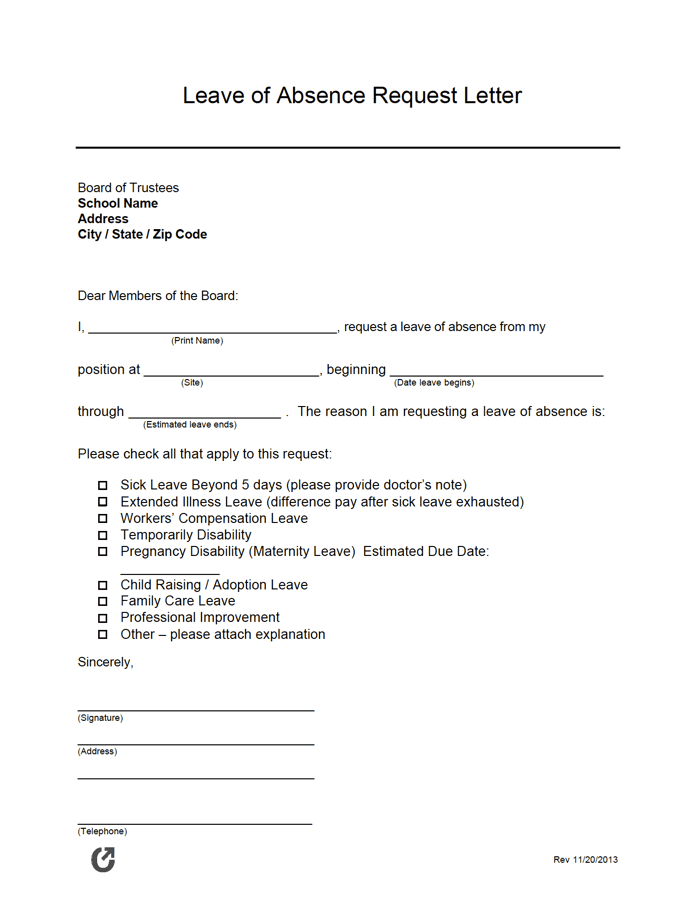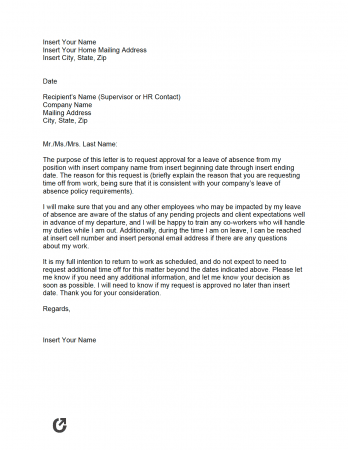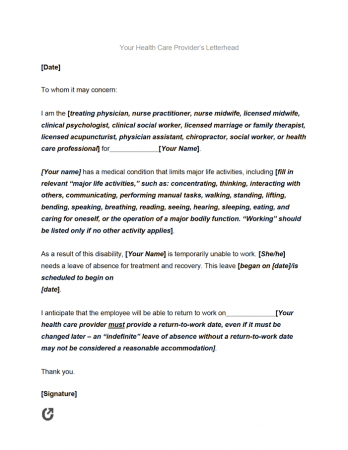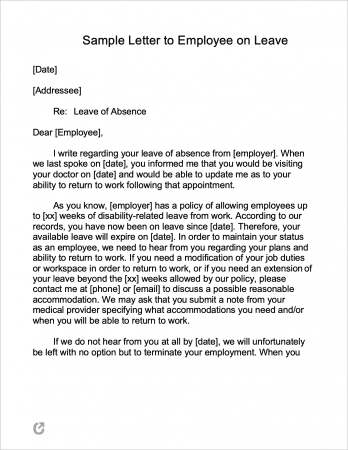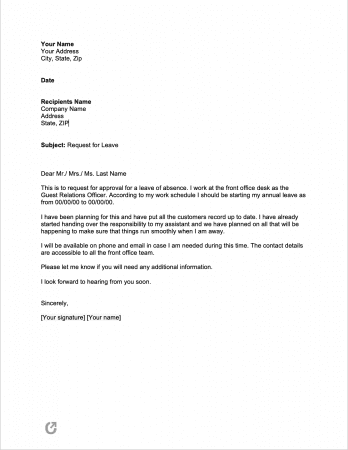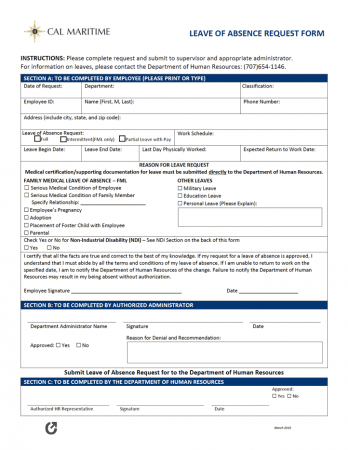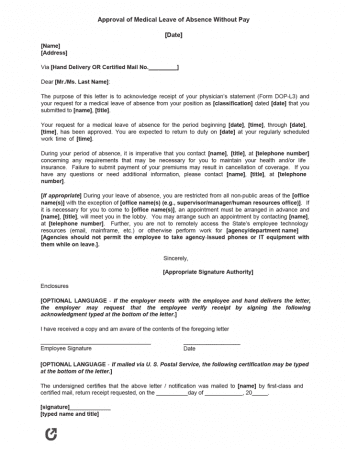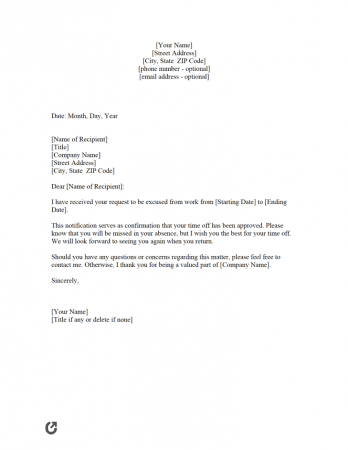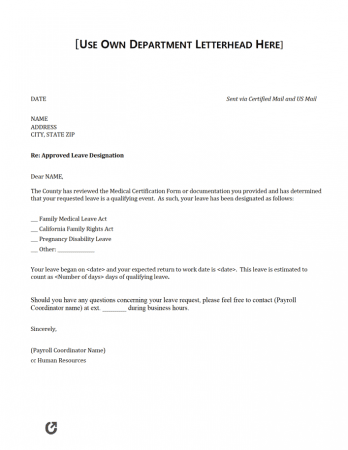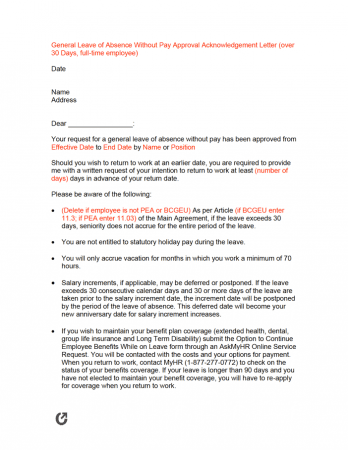Leave of Absence Letter Samples
A letter of absence is written by an employee to ask for a temporary leave from their current job. Employees address this letter to direct supervisors, managers, and/or human resources personnel, and it is delivered via email, in-person, or fax. This letter provides documentation to the employee and the company about the time off, and it communicates all necessary information to the involved parties. Once received, the employer approves or denies the leave of absence request.
Table of Contents |
Leave of Absence Letter Samples
1. PDF | Word (.docx)
2. PDF | Word (.docx)
3. PDF | Word (.docx)
4. PDF | Word (.docx)
How to Write a Leave of Absence Letter
Although there is no single correct way to write a leave of absence letter, the letter must be professional, informative, and timely. It should include the current date, the request for leave, the beginning and end dates of the leave period, and any plans for preparation or coverage during the employee’s absence.
Employers or corporations can require the employee to provide a reason for the leave of absence. For instance, if the worker applies for the Family Medical Leave Act, they must include a statement determining their eligibility.
However, in general, the employee does not need to go into full detail about their situation. Instead, they can use discretion when writing the letter. In this case, statements such as “attending to family issues” or “having a medical procedure” provide sufficient reasoning.
How to Customize a Leave of Absence LetterThe downloadable templates include sample leave of absence letters that you can use; however, you might want to create your own version. In this case, select your favorite PDF or Word Document, then remove any unnecessary text. Next, rewrite the letter in your own words, ensuring that you include essential details. Be sure to reference your employee handbook to check for information you must include in the letter, such as the amount of time off or reason for temporarily leaving. |
Simple Leave of Absence Letters
5. PDF | Word (.docx)
6. PDF | Word (.docx)
7. PDF | Word (.docx)
8. PDF | Word (.docx)
Understanding the Family Medical Leave Act
The Family Medical Leave Act (FMLA) is a law created by the federal government to allow employees to take temporary, unpaid time off. It enables the worker to take temporary leave (up to twelve (12) months). The law’s primary purpose is to guarantee that the employee can resume their position in the company after they take time off. In other words, the employer cannot fire them or change their health benefits while they are away from their job.
An employee is eligible for FMLA if they:
- Give birth or care for a newborn child; or
- Adopt or receive a foster care child;
- Care for an immediate family member (i.e., spouse, parent, child) with a serious health condition; or
- Are unable to work due to a severe medical illness or condition; AND
- Have worked for a covered employer for at least 12 months, with at least 1,250 hours of work before leaving.
An employer has coverage (and thereby can offer FMLA to its employees) if they:
- Are in the private sector and employ 50 or more employees for 20 or more workweeks in the preceding calendar year; or
- Are a public agency (i.e., local, state, or federal government), regardless of the number of employees; or
- Are a public or private elementary or secondary school, regardless of the number of employees.
Leave of Absence Letter Examples
9. PDF
10. PDF
11. PDF
12. PDF
How to Request a Leave from Work
When requesting a leave of absence from work, refer to the company’s policy. Understand if the employer has FMLA coverage and/or the criteria that the employee needs to meet to take time off. If the company has a human resources department, discuss the leave with staff and ask relevant questions.
As soon as the employee takes the initial steps, they should submit a formal leave of absence. Once the worker sends the official document, the company accepts or rejects the request. Each letter remains on file with the employee, even if the employer does not approve the application. It serves as a record and, if accepted, provides guidelines and/or information about the agreement between both parties.
Employees should request leave as soon they can to notify the company properly. However, an individual cannot always predict significant life events. If sudden changes arise that require short- or long-term leave, the worker should give the employer as much notice as possible.
Preparing For Your Leave of AbsenceIf your employer accepts your request, you must follow the guidelines listed in their return letter. For example, if the company requires you to find coverage during your time off, you must act accordingly. Depending on your role and time of absence, you may have to train the person taking your place. If required, you must set specific dates for check-in and inform your boss that you will be coming in or calling on those days. Lastly, you should briefly discuss your time off with your clients if necessary and tell them who will be taking your place. Unless otherwise stated, you do not have to disclose the reason to the customer for your leave. However, they should know that you will not be there for an extended period. |
Leave of Absence Approval Letters
13. PDF | Word (.docx)
14. PDF | Word (.docx)
15. PDF | Word (.docx)
16. PDF | Word (.docx)
17. PDF | Word (.docx)
18. PDF | Word (.docx)
Key Takeaways
Sometimes life events can interfere with an individual’s job – that is normal and often expected. Requesting a formal leave of absence demonstrates self-responsibility, professionalism, and consideration for colleagues. In addition, it communicates necessary information and plans for leaving to the relevant staff.
